The Intel Core i3-7350K (60W) Review: Almost a Core i7-2600K
by Ian Cutress on February 3, 2017 8:00 AM ESTProfessional Performance: Windows
Agisoft Photoscan – 2D to 3D Image Manipulation: link
Agisoft Photoscan creates 3D models from 2D images, a process which is very computationally expensive. The algorithm is split into four distinct phases, and different phases of the model reconstruction require either fast memory, fast IPC, more cores, or even OpenCL compute devices to hand. Agisoft supplied us with a special version of the software to script the process, where we take 50 images of a stately home and convert it into a medium quality model. This benchmark typically takes around 15-20 minutes on a high-end PC on the CPU alone, with GPUs reducing the time.
Here we report the overall time to complete the test – sub-test results can be found in Bench.
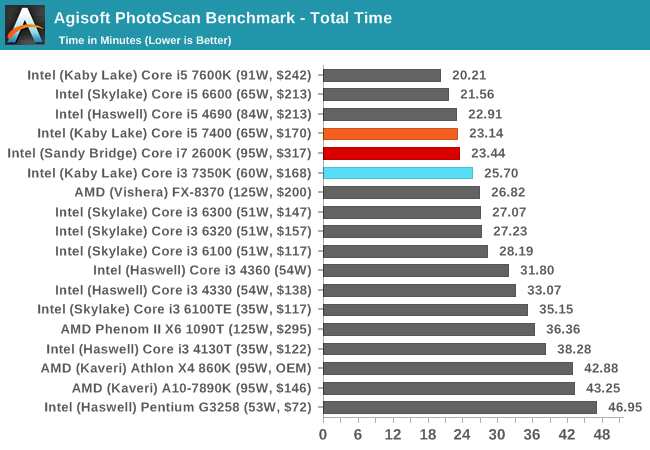
Photoscan is a mix of single and multi-threaded segments, but overall the extra cores in the i5/i7 beat the Core i3, but not by much.
Cinebench R15
Cinebench is a benchmark based around Cinema 4D, and is fairly well known among enthusiasts for stressing the CPU for a provided workload. Results are given as a score, where higher is better.
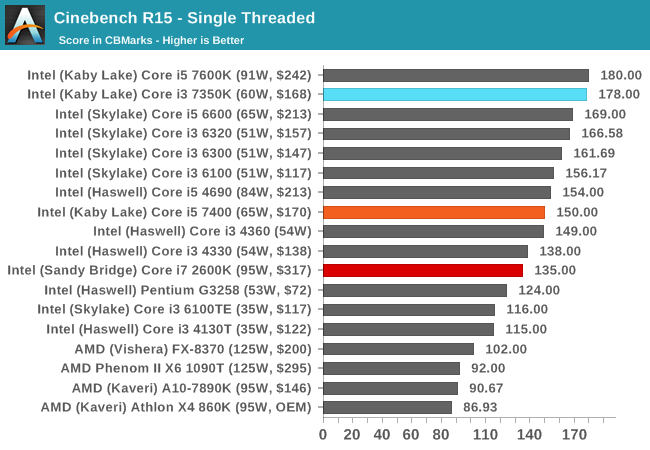
All the Kaby Lake processors seem to do well in CB15 single threaded performance, given that all the K-processors can reach 4.2 GHz or higher one way or another. Nonetheless, the age of the Core i7-2600K is showing here.
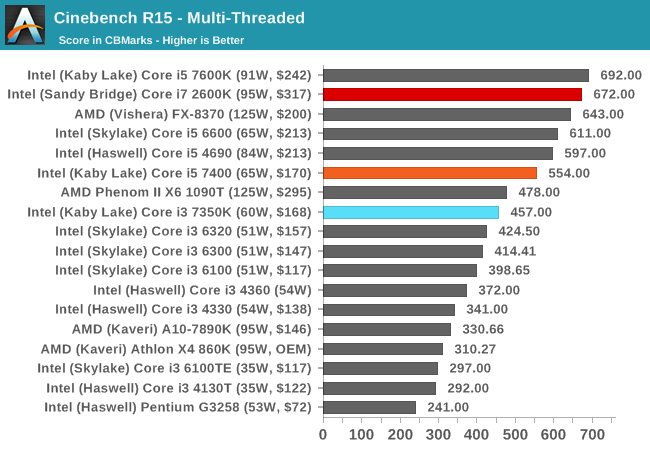
Turning the tables with actual cores, and the Core i7-2600K gets a significant leg up here. The Core i5 also sits above the Core i3.
HandBrake v0.9.9: link
For HandBrake, we take two videos (a 2h20 640x266 DVD rip and a 10min double UHD 3840x4320 animation short) and convert them to x264 format in an MP4 container. Results are given in terms of the frames per second processed, and HandBrake uses as many threads as possible.
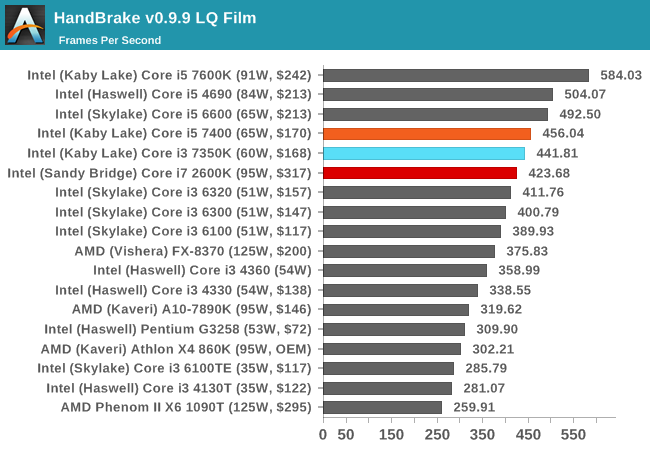

For video conversion, having small frames puts all three CPUs in a similar spot. But ramp up the frame size and we see the Kaby Lake i5 pull ahead due to IPC and instructions. The Core i3 has enough oomph to match the extra threads on the Core i7-2600K though.
Hybrid x265
Hybrid is a new benchmark, where we take a 4K 1500 frame video and convert it into an x265 format without audio. Results are given in frames per second.
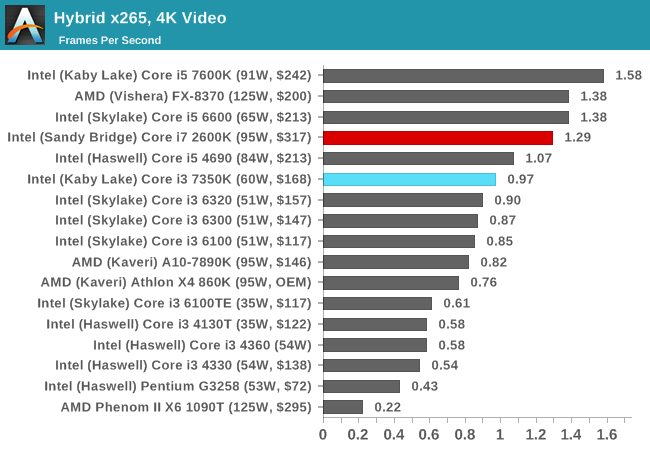
With a different video conversion tool and render, the extra cores and threads of the Core i7 is more than enough to give it a 30% advantage over the Core i3-7350K. It makes me wonder if another +30% frequency would help the Core i3.










186 Comments
View All Comments
Gich - Friday, February 3, 2017 - link
Sure, it's progress... but it used to be much more, much faster... so it doesn't feal progress anymore.StrangerGuy - Friday, February 3, 2017 - link
Things I learned:1. 7350K is hilariously overpriced versus a G4560.
2. Overclocking stock 4.2GHz Intel parts that are already so far from the freq/power sweet spot and little headroom that it's mostly a exercise in futility.
3. That i5 7400 is crazy power efficient.
jaydee - Friday, February 3, 2017 - link
Regarding point #3.It makes you wonder what the "T" designation is really all about. Is the i5-7600T @2.8 - 3.7GHz (35W), basically the same thing as the i5-7400 (65W), only difference being they downclocked the base 200 MHz and upclocked the turbo 200 MHz. On paper you'd expect the "T" to be way more power efficient, but in actuality I bet they are about the same.
Dr. Swag - Friday, February 3, 2017 - link
Hey Ian, correct me if wrong, but couldn't you have just downclocked a 7600k to "simulate" an i5 7400? Afterall, the cache is the same so it should be the same except for the TDP...fanofanand - Friday, February 3, 2017 - link
That would produce a ton of new variables though, i7's theoretically have gone through more exhaustive binning and are a "higher quality" chip that should be able to operate at higher frequencies with lower voltage. Should being an important caveat there.snarfbot - Friday, February 3, 2017 - link
i think microcenter was selling 2600k's for 230 bucks. so 6 years later and you get this pos. progress.fanofanand - Friday, February 3, 2017 - link
MicroCenter has long been offering sweetheart mobo + cpu deals, including the 7700K, so I'm not sure what you think you are proving with your comment. Go look at this processor with a mobo at MicroCenter and you tell me what you see.CaedenV - Friday, February 3, 2017 - link
2600 was $230, 2600k was $280I only know because I didn't sleep for a week while I made the decision lol. Ended up with the 2600 non-k because it still boosted to 4.2GHz just fine and that was more than enough horsepower for me. Been using it for 6 years... omg... how is there no clear upgrade yet?
SaolDan - Friday, February 3, 2017 - link
Excellent!Mr Perfect - Friday, February 3, 2017 - link
Wouldn't testing on Windows 10 have changed the results in favor of the i3 a little? It can't use it's Speed Shift v2 in Windows 7.